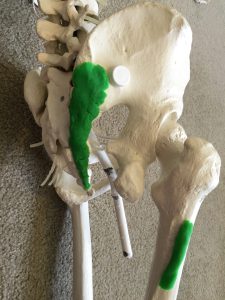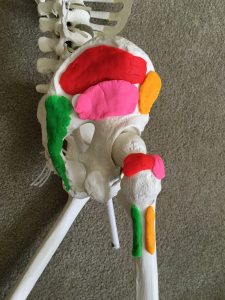Instead of stretching the Iliotibial (IT) Band, turn your focus toward the muscles that connect to the IT Band and those that are part of the larger fascial network. The IT Band, also known as the Iliotibial Tract is a collection of tendon and fascia that connects muscle to bone.
The IT band connects the tensor fascia latae muscle and the gluteus maximus muscle to the lateral tibia and fibula bones. The IT band gets a lot of grief – but is not always the source of the pain it gets blamed for. Muscle and fascial anatomy clear up some of the confusion.
The IT Band is connective tissue, not muscle. This means it stretches, and can be pulled by way of other fascial connections, but doesn’t have the ability to contract the way that muscles do. Without the ability to contract effectively, connective tissue has no other choice than to be pulled and stretched by the muscles it connects to – which results in the feeling of tightness.
Connective tissue requires attention to the muscle(s) it connects to. Muscles become “un-tight” by relaxing. There is a lot of value in stretching and myofascial release work. If rolling and stretching the IT Band (and vastus lateralis -which is deep to IT Band) directly isn’t alleviating the tightness, try this.
Identify the muscles the IT Band connects to and use these two approaches.
- Avoid over-working the muscles.
- Ensure proper recovery for the muscles with massage, stretching, etc.
Here are the two muscles the IT Band connects to directly. Indirect fascial connections to other muscles are also important to consider.

Gluteus Maximus
Attachments: Iliac Crest, Sacruum and Coccyx to Greater Trochanter on Femur.
Actions: Hip Extension, External Rotation, and Abduction.
This is the bulky muscle known as the butt. But….remember there are two other gluteal muscles (gluteus minimus and gluteus medius) comprising the tissue you feel back there.
The green play-doh on Andy the Skeleton represents Gluteus Maximus.
- Find the attachment sites on yourself to connect better with where this muscle is.
- Palpate the attachments and see if you can get the muscle to contract by performing the actions listed above.
- Place a balloon or rubber band on the two attachment sites on a partner to visualize where the muscle is and see how it contracts when the body moves.
Tensor Fascia Latae (TFL)
Attachments: Anterior Iliac Crest to IT Band.
Actions: Hip Flexion, Internal Rotation, and Abduction.
This is a muscle that often gets tight and many people think it’s their hip flexor. But, it’s TFL – which flexes the hip very well.
The orange play-doh on Andy the Skeleton represents TFL.
- Find the attachment sites on yourself to connect better with where this muscle is.
- Palpate the attachments and see if you can get the muscle to contract by performing the actions listed above.
- Place a balloon or rubber band on the two attachment sites on a partner to visualize where the muscle is and see how it contracts when the body moves.
IT Band Tightness and Treatment
Now that you know the two muscles that attach to the IT Band you can elevate body awareness to identify the possibility of over-training. Imbalanced exercise routines and inadequate recovery can lead to tightness, compensation, and injury. In other words, if the gluteus maximus and TFL are getting more exercise than some of the other 21 hip muscles they might get tight and irritated from the extra work.
Beyond addressing the muscles that connect directly to the IT Band you can bring attention toward the fascial relationships in the body and consider tightness above the hip in the obliques or below the hip in the tibialis anterior. Anatomy Trains by Tom Myers reviews this relationship in further detail.
Knowing the location of muscles and the chains of movement they participate in reveals if exercise programs, recovery, and self-care techniques are working or not. Teaching anatomy and body awareness to your clients to address concerns with tightness using various approaches catered to each individual client will set you apart from other personal trainers.
[info type=”facebook”]Join the anatomy conversation on the NFPT Facebook Community Group.[/info]
Expand your anatomy knowledge further with NFPT’s Fundamentals of Anatomy Program.
Balloons, play-doh, pipe cleaners, and ribbons are used to demonstrate each muscle with its attachment point on a skeleton model in a series of videos. You’re also shown how to find the attachments on yourself and/or clients. Application exercises and guided visualizations are also provided along with a 50-page workbook.
References
Abrahams, P.H. et al. 2003. McMinn’s Color Atlas of Human Anatomy. London: Elseiver.
Muscolino, Joseph E. 2004. Musculoskeletal Anatomy Coloring Book. Philadelphia, PA: Mosby, Inc.
Myers, Thomas W. 2014. Anatomy Trains – Myofascial Meridians for Manual & Movement Therapists. Italy: Elseiver.
Beverly Hosford, MA teaches anatomy and body awareness using a skeleton named Andy, balloons, play-doh, ribbons, guided visualizations, and corrective exercises. She is an instructor, author, and a business coach for fitness professionals. Learn how to help your clients sleep better with in Bev's NFPT Sleep Coach Program and dive deeper into anatomy in her NFPT Fundamentals of Anatomy Course.


